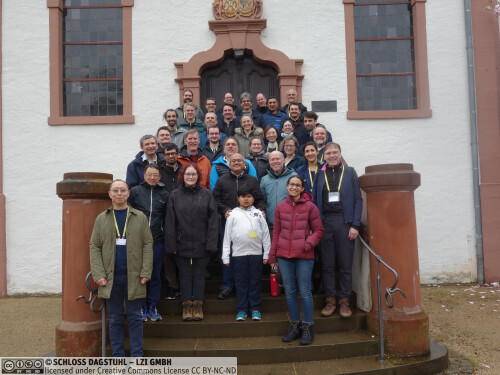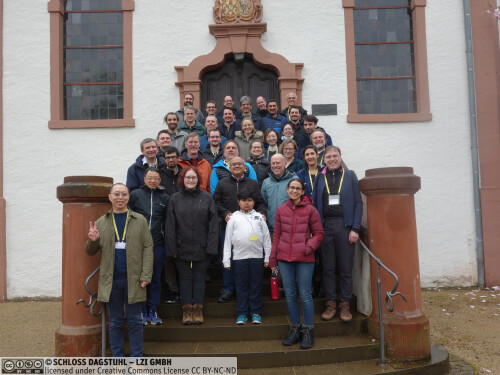Dagstuhl-Seminar 24141
Network Calculus
( 01. Apr – 04. Apr, 2024 )
Permalink
Organisatoren
- Steffen Bondorf (Ruhr-Universität Bochum, DE)
- Anne Bouillard (Huawei Technologies - Boulogne-Billancourt, FR)
- Markus Fidler (Leibniz Universität Hannover, DE)
- Jörg Liebeherr (University of Toronto, CA)
Kontakt
- Michael Gerke (für wissenschaftliche Fragen)
- Christina Schwarz (für administrative Fragen)
Dagstuhl Reports
As part of the mandatory documentation, participants are asked to submit their talk abstracts, working group results, etc. for publication in our series Dagstuhl Reports via the Dagstuhl Reports Submission System.
- Upload (Use personal credentials as created in DOOR to log in)
Dagstuhl Seminar Wiki
- Dagstuhl Seminar Wiki (Use personal credentials as created in DOOR to log in)
Gemeinsame Dokumente
- Dagstuhl Materials Page (Use personal credentials as created in DOOR to log in)
- Dagstuhl Seminar: Network Calculus - Leibniz Universität Hannover, Institut für Kommunikationstechnik: Aktuelles, February 28, 2024
Network calculus has become a mature and versatile methodology for the analysis of queueing systems with a broad variety of applications ranging from Internet Quality of Service (QoS), wireless networks, to Ethernet with delay guarantees, real-time systems, and feedback control. This is achieved through complementary, problem-specific representations in min-plus or max-plus algebra and the use of worst-case or statistical bounds. The goal of this Dagstuhl Seminar is to gather the deterministic and stochastic Network Calculus community, to discuss recent research activities, to identify future directions, and to strengthen cooperation. The challenges to be discussed arise in these areas:
Algebras, performance metrics and bounds: Network Calculus has a fundamental representation as a systems theory under the min-plus algebra. Related are theories, e.g., for discrete-event systems, that use a max-plus algebra, and there is also a branch of the Network Calculus that uses max-plus. An important application is recent age-of-information research. A further, methodological connection with the min-plus/max-plus systems theory of the Network Calculus may be developed in the field of feedback control of max-plus linear systems. We expect that input from the control and discrete event community to the seminar will give fresh momentum and may motivate novel joint research.
Network topology and parallel systems: A remarkable quality of the Network Calculus is its modeling power: a wide variety of systems, such as links, traffic shapers, and scheduling policies can be modeled and composed into arbitrary topologies. Some advanced results from the deterministic Network Calculus, namely the pay bursts/multiplexing only once phenomena, have only recently been incorporated into the stochastic Network Calculus. Continuing this effort requires a strong cooperation between both communities, given their complementary expertise. Another important aspect to be advanced together are parallel systems, as found in multi-path transport and in fork-join models.
TSN, DetNet, URLLC: Since recently, there has been a surge of interest in technologies for reliable and low-latency communications. Prominent examples are IEEE Time Sensitive Networking (TSN), IETF Deterministic Networking (DetNet), and 5G Ultra-Reliable Low Latency Communications (URLLC). These technologies are closely intertwined with the Network Calculus with essential applications in, e.g., factory automation, aerospace onboard, and automotive in-vehicle networks.
Algorithms and tools: Recent developments in Network Calculus algorithms can be classified as a) combining modular and optimization approaches; and b) highly parallelizable methods that iteratively improve the performance bounds. The former trend requires finding an appropriate decomposition, which can, for example, be resolved with machine learning techniques. Integrating these streams and their tool development opens up the opportunity for rapid dissemination of novel results, extensive community-based research artifact evaluation and reproducibility verification.
Design automation and configuration synthesis: Rather than aiming for a performance analysis of a fully configured system, constructive methods seek to design and configure a system that meets given performance requirements. Adapting Network Calculus for design automation and configuration is a fundamental challenge. How Network Calculus modeling and analysis can allow for such an adapted procedure with open parameters is not yet investigated in sufficient detail. Among the tools that could be used for solving such problems are, again, optimization and machine learning.
 Steffen Bondorf, Anne Bouillard, Markus Fidler, and Jörg Liebeherr
Steffen Bondorf, Anne Bouillard, Markus Fidler, and Jörg Liebeherr
- Michael Beck (University of Winnipeg, CA) [dblp]
- Steffen Bondorf (Ruhr-Universität Bochum, DE) [dblp]
- Anne Bouillard (Huawei Technologies - Boulogne-Billancourt, FR) [dblp]
- Marc Boyer (ONERA - Toulouse, FR) [dblp]
- Peter Buchholz (TU Dortmund, DE) [dblp]
- Almut Burchard (University of Toronto, CA) [dblp]
- Georg Carle (TU München - Garching, DE) [dblp]
- Samarjit Chakraborty (University of North Carolina at Chapel Hill, US) [dblp]
- Vlad-Cristian Constantin (RPTU - Kaiserslautern, DE)
- Hugo Daigmorte (RealTime-at-Work - Nancy, FR)
- Markus Fidler (Leibniz Universität Hannover, DE) [dblp]
- Anaïs Finzi (TTTech Computertechnik - Wien, AT)
- Stéphane Gaubert (INRIA & CMAP, Ecole polytechnique - Palaiseau, FR) [dblp]
- Damien Guidolin--Pina (RealTime-at-Work - Nancy, FR)
- Anja Hamscher (RPTU - Kaiserslautern, DE)
- Max Helm (TU München - Garching, DE)
- Kai-Steffen Jens Hielscher (Universität Erlangen-Nürnberg, DE) [dblp]
- Yuming Jiang (NTNU - Trondheim, NO) [dblp]
- Kai Lampka (NXP Semiconductors - München, DE) [dblp]
- Jean-Yves Le Boudec (Jouxtens-Mézery, CH) [dblp]
- Harvinder Lehal (University of Toronto, CA)
- Jörg Liebeherr (University of Toronto, CA) [dblp]
- Lisa Maile (Universität Erlangen-Nürnberg, DE)
- Mahsa Noroozi (Leibniz Universität Hannover, DE)
- Xi Peng (Huawei Technologies - Hong Kong, HK)
- Stéphan Plassart (University Savoie Mont Blanc - Annecy, FR)
- Amr Rizk (Universität Duisburg-Essen, DE) [dblp]
- Giovanni Stea (University of Pisa, IT) [dblp]
- Mina Tahmasbi Arashloo (University of Waterloo, CA) [dblp]
- Ludovic Thomas (CNRS - Villers-lès-Nancy, FR)
- Brenton Walker (Leibniz Universität Hannover, DE)
- Kui Wu (University of Victoria, CA) [dblp]
- Raffaele Zippo (University of Pisa, IT)
Klassifikation
- Networking and Internet Architecture
- Performance
Schlagworte
- Network calculus
- effective bandwidths
- queueing network
- performance evaluation
- age of information



 Creative Commons BY 4.0
Creative Commons BY 4.0
